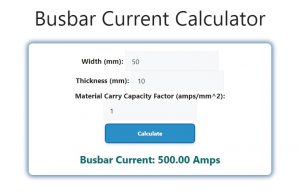About Busbar Current Calculator (Formula)
The Busbar Current Calculator is an essential tool used in electrical engineering to determine the current-carrying capacity of busbars. Busbars are metallic strips or bars that conduct electricity within a power distribution system. Understanding the current capacity of busbars is crucial for ensuring the safety and efficiency of electrical systems, as it helps prevent overheating and potential failures. This article will guide you through the formula, its application, and provide a comprehensive understanding of how to use the calculator effectively.
Formula
The formula for calculating the busbar current is:
Busbar Current = Width * Thickness * Material Carry Capacity Factor
Where:
- Busbar Current is the maximum current that the busbar can safely carry, measured in amperes (A).
- Width is the width of the busbar in millimeters (mm).
- Thickness is the thickness of the busbar in millimeters (mm).
- Material Carry Capacity Factor is a coefficient that represents the material’s ability to conduct electricity, which varies based on the type of material used.
How to Use
- Determine Dimensions: Measure the width and thickness of the busbar in millimeters (mm).
- Identify Material: Identify the type of material used for the busbar (e.g., copper, aluminum) and find its corresponding material carry capacity factor.
- Apply the Formula: Substitute the width, thickness, and material carry capacity factor into the formula to calculate the busbar current.
- Analyze Results: Evaluate the calculated busbar current to ensure it meets the requirements of your electrical system.
Example
Consider a copper busbar that is 50 mm wide and 10 mm thick. The material carry capacity factor for copper is approximately 1.0. To calculate the busbar current, use the formula:
Busbar Current = Width * Thickness * Material Carry Capacity Factor
Busbar Current = 50 mm * 10 mm * 1.0
Busbar Current = 500 A
Therefore, this copper busbar can safely carry a current of 500 amperes.

FAQs
- What is a busbar?
A busbar is a metallic conductor that distributes electrical power to various circuits in an electrical system. - Why is it important to calculate busbar current?
Calculating busbar current ensures that the busbar can handle the expected electrical load without overheating or failing. - What units are used for busbar current?
Busbar current is measured in amperes (A). - How do I measure the width and thickness of a busbar?
Use a caliper or ruler to measure the dimensions of the busbar in millimeters (mm). - What is the material carry capacity factor?
The material carry capacity factor is a coefficient that indicates the ability of a material to conduct electricity; it varies by material type. - Can I use this calculator for different materials?
Yes, you can use the calculator for various materials by applying the respective material carry capacity factor for each. - What happens if I exceed the calculated busbar current?
Exceeding the calculated busbar current can lead to overheating, potential damage, and safety hazards. - Is there a standard thickness for busbars?
No, the thickness of busbars varies based on the specific application and required current capacity. - Can this calculator be used for busbars of any shape?
The calculator is primarily for rectangular busbars. For different shapes, consult specific design guidelines. - How often should busbars be inspected?
Regular inspections are recommended, particularly in high-load environments, to ensure safety and reliability. - What materials are commonly used for busbars?
Common materials include copper and aluminum due to their excellent conductivity. - What is the effect of temperature on busbar current capacity?
Higher temperatures can reduce the current-carrying capacity, increasing the risk of overheating. - Can I use this formula for high-voltage applications?
Yes, but additional considerations for insulation and safety must be taken into account for high-voltage systems. - How does the width of a busbar affect its current capacity?
Wider busbars can carry more current, as they have a larger surface area for heat dissipation. - What safety standards apply to busbars?
Busbars must comply with local electrical codes and safety standards to ensure safe operation. - Are there software tools available for busbar calculations?
Yes, various software tools can help automate busbar current calculations and design processes. - What are the consequences of using undersized busbars?
Using undersized busbars can lead to overheating, electrical failures, and increased fire risks. - How can I improve the current-carrying capacity of a busbar?
You can improve capacity by increasing the width or thickness, using a better conductive material, or cooling solutions. - Is it necessary to consult an engineer for busbar design?
Consulting an engineer is advisable, especially for complex systems or high-load applications. - What is the typical application of busbars?
Busbars are used in substations, switchgear, industrial plants, and power distribution systems.
Conclusion
The Busbar Current Calculator is a vital tool for ensuring the safe and efficient operation of electrical systems. By accurately calculating the current-carrying capacity of busbars based on their dimensions and material properties, users can prevent overheating and ensure reliable power distribution. Understanding how to use this calculator effectively contributes to the overall safety and efficiency of electrical installations, making it an essential resource for engineers and technicians in the field.